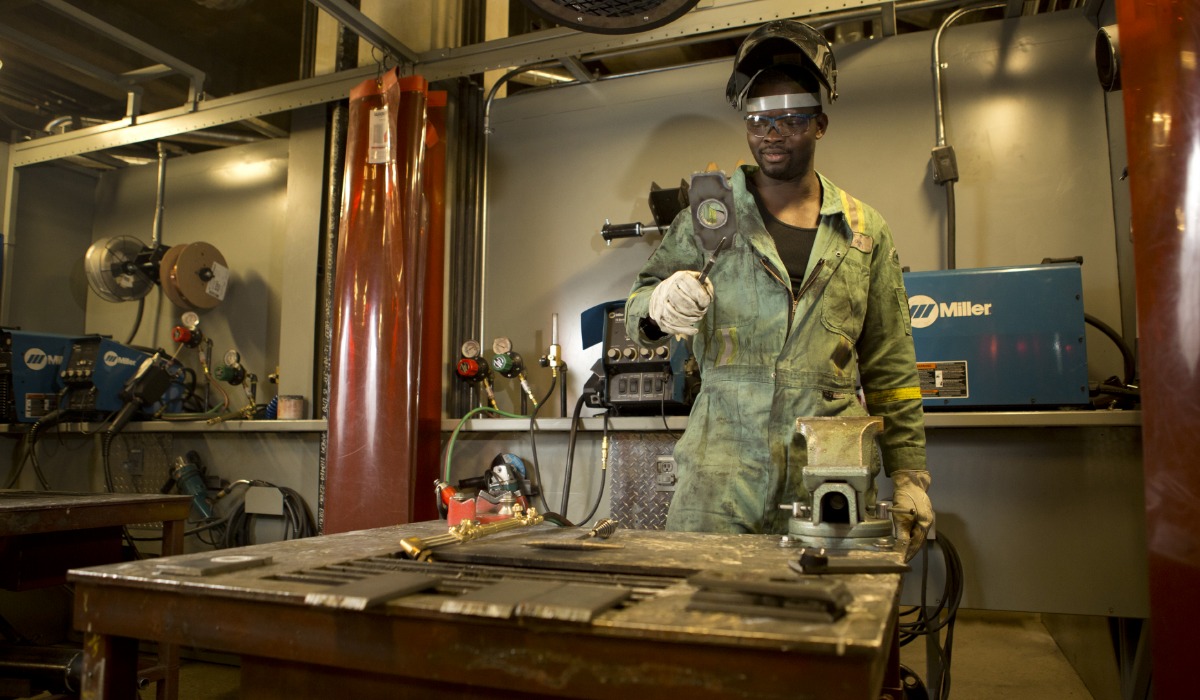Overview
Learn to layout, assemble, maintain and repair piping systems which carry water, steam, chemicals or fuel used in heating, cooling, lubricating and other processes.
As a steamfitter-pipefitter, you’ll:
- install a typical piping system in a commercial building or industrial plant
- study blueprints, drawings or specifications to determine the type of pipe and tools to use
- make detailed sketches for pipe and equipment fabrication and installation
- measure, cut, thread, groove, bend, assemble and install metal, plastic and fibreglass pipes, valves and fittings
- join pipe sections and related equipment to secure them into position
- use testing equipment to check systems for leaks.
You may also remove and replace worn components, do general maintenance work and work on plant shut-downs.
Certification is required to work in this trade. This means you must either be a registered apprentice working under the guidance of a certified journeyperson or you must be a journeyperson yourself.
Steamfitter pipefitters are skilled tradespeople who like working with their hands on physically demanding tasks.
This line of work is most fulfilling for those who enjoy working independently.
To succeed in this trade, you should:
- enjoy problem-solving
- be a creative thinker
- be able to visualize and execute complex instructions
- enjoy working in physically active environments
- have mechanical ability and manual dexterity
- be able to accurately estimate and measure sizes and lengths
- be comfortable working independently
- be committed to maintaining safe working conditions.
Upon successfully completing the required working hours and technical training periods, you'll be awarded an advanced diploma and journeyperson status by Alberta’s Apprenticeship and Industry Training.
This is a Red Seal Endorsed trade – a recognizable standard that allows tradespeople to work across Canada.
Careers and opportunities
Our graduates may work in the following occupations. Some careers require additional experience and education.
Associated National Occupational Classification (NOC) codes: 72012, 72300, 72301, 72302, 72501, 74204, 92101.
Apprenticeship training
The term of apprenticeship for a steamfitter pipefitter is four years (four 12-month periods), including a minimum of 1560 hours of on-the-job training and eight weeks of classroom instruction each year.
Year 1 | Period 1
You’ll learn standard workplace safety, rigging, tools, equipment and materials. You’ll also cover metal fabrication, drawing and specifications, calculation and science.
All year 1 Plumber, Gasfitter, and Steamfitter apprentices will share a common schedule, attending all classroom instruction and labs together.
Training length: 8 weeks
Year 2 | Period 2
You’ll learn about heating systems, hydronic heating, rigging equipment and hoisting communication, specialty piping, gas fitting fundamentals, drawings, layouts and elevations.
Training length: 8 weeks
Year 3 | Period 3
You’ll learn about low-pressure steam and condensate systems, instrumentation and trade technologies, welding processes, hoist planning and cranes, process diagrams and mitre elbows.
Training length: 8 weeks
Year 4 | Period 4
You’ll learn about high-pressure steam and condensate systems, process piping systems, job planning and lifts, revised drawings and projects.
Training length: 8 weeks
Apprenticeship education performance
You must pass each section of the course and the AIT exam to succeed in apprenticeship education.
The passing grade for each period is no less than 50% in each course, with no less than a 65% average overall. A passing mark on each provincial exam and the interprovincial qualification (Red Seal Exam) is 70%.
View Alberta's Apprenticeship and Industry Training procedures
Training pathways
You can earn your journeyperson designation in the following way.
The traditional training pathway begins with finding a job with an employer willing to indenture you as an apprentice. Once you are an apprentice, you will alternate between on-the-job training and educational periods.
You must apply for an apprenticeship through Alberta Apprenticeship and Industry Training before attending your first education period at SAIT.
Pre-employment pathway
SAIT’s Pre-employment Pipetrades program prepares you to enter into an apprenticeship with hands-on skills. Upon successfully completing the program, you’ll qualify to take the first-year Gasfitter, Plumber and Steamfitter Pipefitter apprenticeship exams.
Admission requirements
To enter an apprenticeship, you must have the educational qualifications required or recommended education for the trade to which you apply.
Entrance requirements are monitored and set by Alberta Apprenticeship and Industry Training.
Minimum requirements
Successful completion of the following courses:
- English 20-2
- Math 20-3
- Science 10
OR
A pass mark in all five Canadian General Educational Development (GED) tests
OR
Alberta Apprenticeship and Industry Training Entrance exam.
Recommended requirements
Apprentices with an Alberta High School Diploma that includes the following courses:
- English 30-2
- Math 30-3
- Physics 30 OR Chemistry 30 OR Science 30
- Related career and technology studies (CTS) courses
MyTradeSecrets
Once you have begun working as an apprentice, you can attend SAIT to complete your technical training.
You'll register for technical training at SAIT on MyTradeSecrets or you can register by phone.
Transfer agreements
At SAIT, we have created transfer agreements with partner institutions to allow you to earn course credits toward your SAIT program based on your previously completed credentials.
Transfer Alberta search tool
Use the Transfer Alberta search tool to see all transfer agreements between Alberta post-secondary institutions (including those with the University of Calgary, Mount Royal University and Bow Valley College.)
Search transfer agreements in Alberta
Transfer options for graduates
When you have completed this program, you may continue your education at a partner post-secondary institution. These transfer agreements include partnerships within and/or outside of Canada.
Credits this program transfers to
- Available credits:
- 45
As a certified tradesperson with at least one year of full-time work experience in the field and the necessary English and introductory business prerequisites, you can apply to the University of the Fraser Valley’s Bachelor of Business Administration for Trades Management.
This five (5) semester program complements your prior learning with the fundamentals of business management theories and practices. This will help you successfully function as a manager or owner of a trade-related business in today's rapidly changing global environment.
- Available credits:
- 57
- Available credits:
- 60
Available intakes
Costs
2025/26 tuition and fees
The following costs are effective as of July 1, 2025.
This is a bring-your-own-device program with standard computer hardware and software requirements. See the specific requirements on our computers and laptops page.
Books or modules, along with other items for classes, are approximately $600 per period.
We recommend you don't purchase books or modules ahead of time as they might be outdated by the time you attend classes, and they cannot be returned to the Bookstore.
This program requires personal protective equipment (PPE), which may be an additional cost.
Funding options for apprentices
Apprentices get to learn while they earn, but there are still costs to consider. Many resources are available at SAIT and federally to help support apprentices.
Information sessions
Prepare for a strong start in your chosen program or get the details you need to decide your future path.
Our expert staff and faculty are ready to answer your questions and provide information about the following:
- What sets SAIT apart
- An introduction to the program and area of study
- Admission requirements
- Future career paths
- Information on the earning potential and graduate employment rates.
Contact
Have more questions?
Apprenticeship training and registration
Apprenticeship and Industry Training Client Services

Oki, Âba wathtech, Danit'ada, Tawnshi, Hello.
SAIT is located on the traditional territories of the Niitsitapi (Blackfoot) and the people of Treaty 7 which includes the Siksika, the Piikani, the Kainai, the Tsuut’ina and the Îyârhe Nakoda of Bearspaw, Chiniki and Goodstoney.
We are situated in an area the Blackfoot tribes traditionally called Moh’kinsstis, where the Bow River meets the Elbow River. We now call it the city of Calgary, which is also home to the Métis Nation of Alberta.
